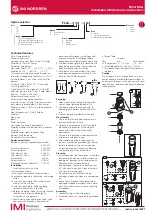
36
pressure of filtrate header pipe is stabilized.
(5)
Monitor the pressure decay (
Δ
p) of the feed air pressure for 5 to 10 minutes,
dependent on the number of elements. See Fig. 17 for examples of pressure
decay due to one broken membrane fiber. If pressure decay is excessive, a
visual inspection of the element will be required (see step 7). The pressure
decay rate depends on the H. The Fig. 10 shows in case of H = 0.1 m.
Please correct the Fig. 17 by using the actual H.
(6)
Diffusion of air through the water filled pores of the membrane fiber leads to
a pressure decay of approximately 1 kPa in 5 minutes (dependent on the
volume of the pipe work manifolds, etc.). A single broken membrane fiber in
128 HSU-1515 elements gives a pressure decay of approximately 5 kPa in 5
minutes, so a decay of 5 kPa in 5 minutes is normally used to indicate the
presence of a single broken membrane fiber for this size of unit.
(7)
In case of the pressure decay is excessiveness, identify the elements with
broken membrane fibers by visual check of water surface (bubbling) in the
submerged tank. The pressure time should be kept within 15 minutes to keep
from drying out of the membrane.
(8)
Mark any leaking elements for subsequent replacement.
(9)
After the 3 to 10 minutes pressure hold test period (or after identifying the
elements with broken membrane fibers), relieve pressure in the permeate
side of the membrane element by opening the air vent valve (V-7). If there
are elements with broken membrane fibers, dismount it after the pressure
release.
(10) Open the backwash valve (V-5), run the backwash pump and vent air from
the filtrate manifold through the V-7.
(11) After venting air from the filtrate line, close the V-5 and the V-7, then stop the
backwash pump.
(12)
The unit is now ready for processing.
Содержание HSU-1515
Страница 20: ...18 2 Configuration Rack Model R16 ...
Страница 21: ...19 Rack Model R08 ...








































